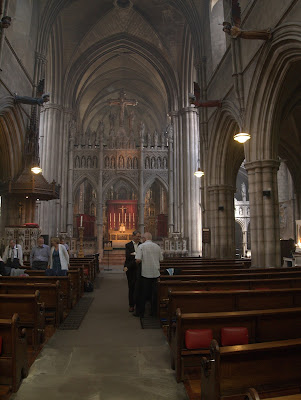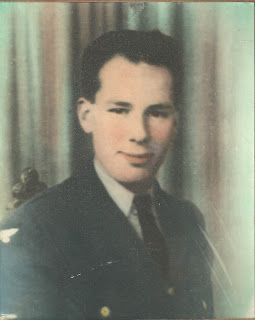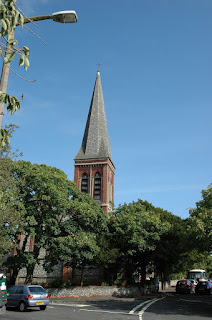Race against time
It would seem that I have started a race to summer. A church for whom I play asked me for dates up to June, and I thought they were getting well ahead and nicely organised. I looked in my diary and found that, between then and today, I have only four Sundays free.
The same church has got back to me today, and asked for dates through to August! Now that is organised - no pun intended.
I do enjoy playing for different churches. For decades I was attached to one console or another, from my first job at St Peter's, Acton Green at age 14, to the last at St Bendybus, Hove. The variety of organs was huge: from 2-manuals and 10 stops (Peter Collins, 1974) to three and 70 stops (Noël Mander, 1964). They've been far too loud, too soft, on the west wall, buried in a chancel cavity, and, just occasionally, right. My favourite organ was St Augustine's, in Brighton. With three manuals, 42 stops it was certainly not small, but the sounds it produced belied the nameplate on it - Morgan & Smith, 1940. It turned out that it could be by Hill, Norman and Beard, subcontracting? There was a signature on one pipe of the Swell Contra Fagotto which more than hinted at the possibility. Alas, now destroyed. The church closed, and my efforts to rehome it were to no avail. The name-plate was against it. Sad. It would not have been out of place as the west organ for Chichester Cathedral, in my oh-so-humble opinion. Funds.
You can see that the old façade pipes from 1896 made it inside the case as the new Number 2 Open Diapason. The woodwork (pics 1 & 2) was renewed and the pipes repainted after an arson attack in the church in the 70s. Made it look in better condition than it was, but it produced a well-integrated sound, when it all worked. The console was opposite the organ, and the organist faced east. This meant that any injudicious word muttered by the organist would bounce straight back down the nave off the music desk... Architecturally, the church was a joy at the east end, a semi-circular ambulatory behind the choir stalls and high altar, beautifully executed. Wikipedia has an article: incomplete and with minimal pictures, but nevertheless something. I wish I'd photographed the Kempe glass - of national importance. Plans seem to include this, but according to the wiki article have been scaled back somewhat. I am glad it won't be demolished, but with a little foresight and flexibility it might have continued as a church. Never mind. Thank heavens they never built the 150' tower!
The same church has got back to me today, and asked for dates through to August! Now that is organised - no pun intended.
I do enjoy playing for different churches. For decades I was attached to one console or another, from my first job at St Peter's, Acton Green at age 14, to the last at St Bendybus, Hove. The variety of organs was huge: from 2-manuals and 10 stops (Peter Collins, 1974) to three and 70 stops (Noël Mander, 1964). They've been far too loud, too soft, on the west wall, buried in a chancel cavity, and, just occasionally, right. My favourite organ was St Augustine's, in Brighton. With three manuals, 42 stops it was certainly not small, but the sounds it produced belied the nameplate on it - Morgan & Smith, 1940. It turned out that it could be by Hill, Norman and Beard, subcontracting? There was a signature on one pipe of the Swell Contra Fagotto which more than hinted at the possibility. Alas, now destroyed. The church closed, and my efforts to rehome it were to no avail. The name-plate was against it. Sad. It would not have been out of place as the west organ for Chichester Cathedral, in my oh-so-humble opinion. Funds.
 |
| Organ from nave. Note the damp problem in the chancel arch. |
 |
| Console plus organist. M&S's horseshoe consoles. They rarely used drawstops. |
 |
| Pipefront from Decani Bass pew. |
 |
| Great pipework, C-side |
You can see that the old façade pipes from 1896 made it inside the case as the new Number 2 Open Diapason. The woodwork (pics 1 & 2) was renewed and the pipes repainted after an arson attack in the church in the 70s. Made it look in better condition than it was, but it produced a well-integrated sound, when it all worked. The console was opposite the organ, and the organist faced east. This meant that any injudicious word muttered by the organist would bounce straight back down the nave off the music desk... Architecturally, the church was a joy at the east end, a semi-circular ambulatory behind the choir stalls and high altar, beautifully executed. Wikipedia has an article: incomplete and with minimal pictures, but nevertheless something. I wish I'd photographed the Kempe glass - of national importance. Plans seem to include this, but according to the wiki article have been scaled back somewhat. I am glad it won't be demolished, but with a little foresight and flexibility it might have continued as a church. Never mind. Thank heavens they never built the 150' tower!



Comments
Post a Comment